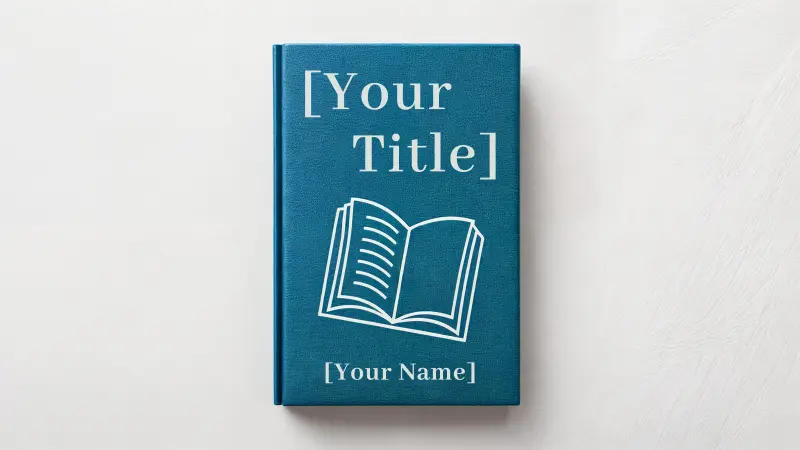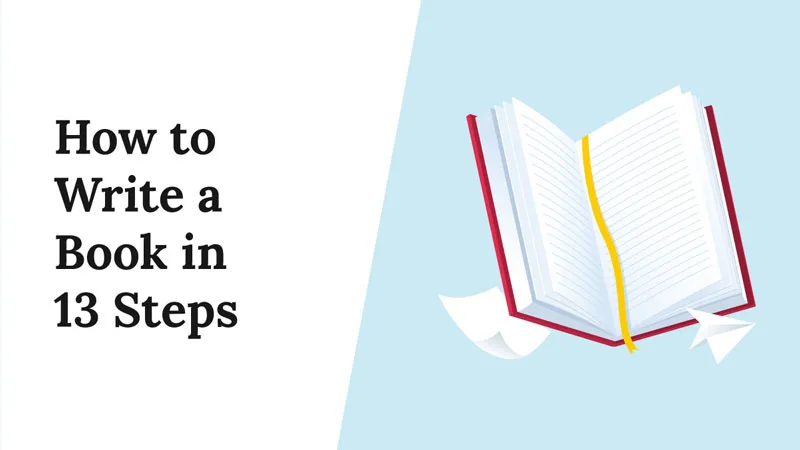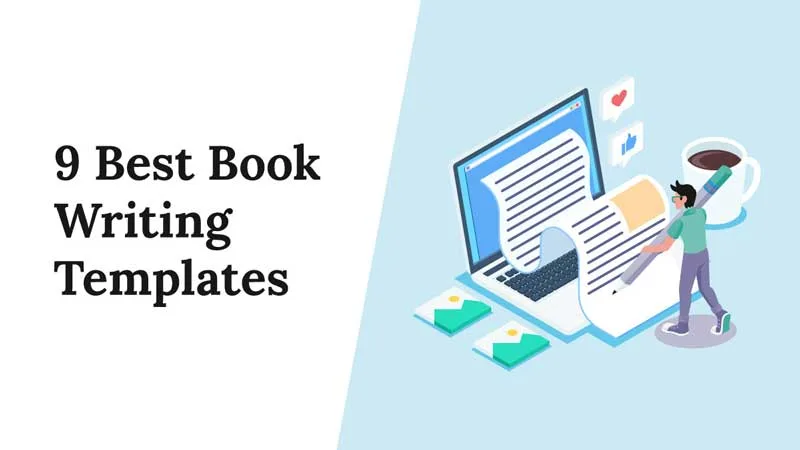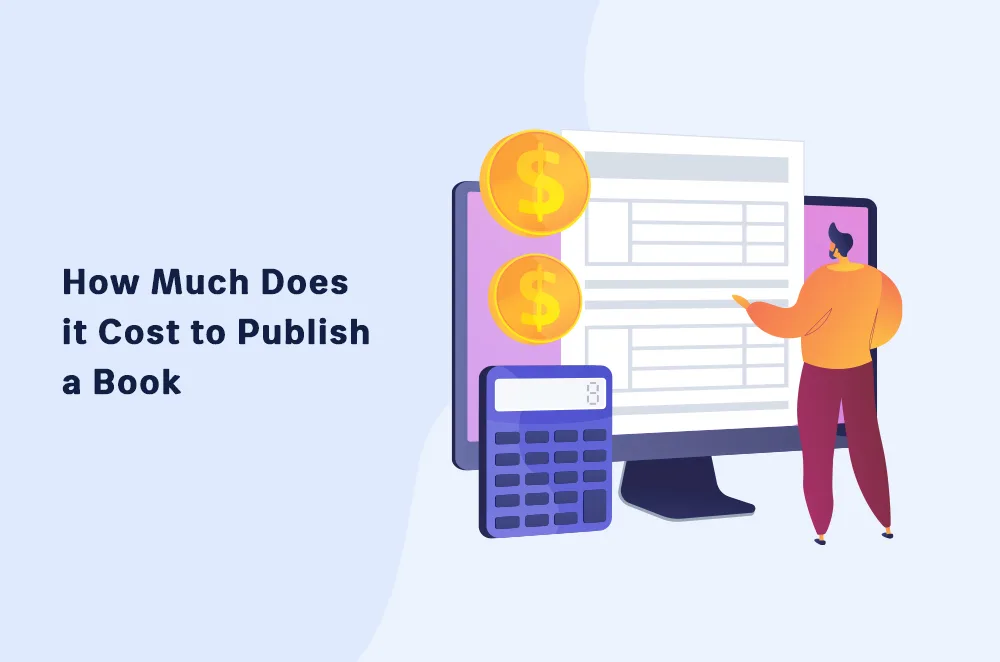What was once controlled by a few publishing houses is now accessible to anyone with a manuscript and an internet connection.
Self-publishing democratized the book industry, allowing authors to bypass traditional gatekeepers and sell their work directly to readers.
This guide walks you through the entire self-publishing journey.
Whether it’s your first book or your fifth, fiction or nonfiction, going from an idea to a published book is not simple. That’s where these nine simple steps will help you write, publish, and share your work.
What It Means to Publish Your Own Book
Before diving into the process, let’s clarify what self-publishing means and how it is different from traditional publishing.
Self publishing means you, the author, are the publisher. You make all the decisions about your book: editing, cover design, formatting, pricing, distribution, and marketing. Various self publishing companies allow writers to host their books on their platforms.
This level of control these companies give you is empowering, but also comes with responsibility. Let’s get cracking on each of them.
Misconceptions About Self-Publishing
There are a lot of misconceptions about self-publishing. Here are 3 examples:.
Misconception #1: Self-Published Books are Low Quality.
Reality: Many self-published books are professionally edited and designed, and you cannot tell them apart from traditional ones. We agree that many are low in quality, mainly because people didn’t put much effort into them. Time, effort, and a good eye for design make you great, whether you publish yourself or traditionally.
Case in point: Amanda Hocking was one of the first self-published authors to earn millions on Amazon with her paranormal romance novels. After years of rejections, she uploaded her books in 2010 and sold over a million copies in a year. Her success led to a book deal with St. Martin’s Press, and she’s now published over 30 bestselling titles.
Misconception #2: You Won’t Make Money in Self-Publishing.
Reality: While success isn’t guaranteed, self-published authors typically earn higher royalties (60-70% compared to 10-15% with traditional publishing).
Your proof: WhenMark Dawson began self-publishing, his breakout success came with The Cleaner, the first book in his John Milton thriller series. This title helped him gain traction and build a large readership. It was a key factor in his rise to selling millions of books.
Misconception #3: Self-Publishing is Just for Rejected Manuscripts.
Reality: Self-publishing means you don’t have to deal with rejection. Your book gets out there no matter what. A lot of authors go for it for the creative freedom in their writing career first, and the business side second.
It’s a great way to test the waters, make some money, and see what sticks. If it takes off, great. If not, you still gave it a shot. Win-win.
Your Proof:A great example of this is Wool by Hugh Howey. He put it up on Amazon in 2011 as a short story for less than a dollar, just to see what would happen. Readers loved it, and the demand was so strong that he kept writing more, eventually turning it into a full series.
Before long, he was selling thousands of copies a month. That success caught the attention of traditional publishers, and he ended up landing a print-only deal with Simon & Schuster.
Why Self-Publishing is Worth It Today
Self-publishing offers many advantages for writers. Some of them are listed below:
Total creative and financial control: From cover design to marketing strategy, make decisions that align with your vision and goals.
Higher royalty rates: You earn 35-70% royalties on self-published books, compared to 10-15% with traditional publishers.
Faster publishing timeline: You skip the long process of pitching, contracts, and production schedules with self-publishing. So, you get your book out in months instead of waiting years.
Global distribution with minimal upfront cost: Reach readers worldwide through platforms like Amazon, Apple Books, and Kobo for little to no initial investment.
Bella Andre is a great example of an author who stayed independent and made it work. She sold over10 million books, built a huge fanbase, and launched her own publishing company, Oak Press, to keep full control.Publishers Weekly even named Oak Press one of the fastest-growing indie publishers. She proves you don’t need a traditional deal to succeed.
How to Publish Your Own Book in 9 Steps

Now that you know self-publishing opens up big opportunities, let’s break down the 9 steps that help you become a successful self-published author.
Step 1 – Develop and Validate Your Book Idea
Your publishing process begins with a solid foundation—a book idea that resonates with readers and stands out in the marketplace.
This means you need to understand who you’re writing the book for and why. Knowing this helps you plan both your book and your launch campaign more effectively.
Identify Your Niche and Ideal Reader
Success starts with understanding where your book fits in the market.
Define Your Genre and Sub-Genre
This sets reader expectations and helps with marketing. For example, rather than just “romance,” specify “contemporary small-town romance” or “paranormal romantic suspense.”
Conduct a Competitive Analysis
Check Amazon bestseller lists and subcategories in your genre. Look for trends in themes, covers, pricing, and reader reviews to spot what works and what’s missing.
Create Reader Personas
Build profiles of your ideal readers, including age, interests, reading habits, and goals. This helps you tailor your writing and marketing.
Tip: Create a few different personas to cover a range of potential readers.
Validate Your Book Concept
Before you write, make sure there’s demand:
Use tools like Publisher Rocket, K-lytics, or Google Trends to research keywords and topics.
Browse Goodreads, Reddit, and BookTok to see what readers care about.
Test your idea with a short pitch. Share it on social media, in newsletters, or ask friends who match your reader personas for feedback.
Set Clear Goals for Your Book
Establish early on what success looks like for you. You can do that by recording the following:
Decide on your primary purpose
: Is this book mainly for profit, brand-building, establishing authority, or for creative fulfillment?
Define specific metrics
: Examples include reaching 1,000 readers in six months, earning $5,000 in the first year, or building your email list to 500 subscribers.
Create a timeline
: Work backward from your publication goal to establish milestones for writing, editing, design, and launch preparations.
Step 2 – Write and Refine Your Manuscript
With great concept validation comes a greater responsibility – towrite a book. It’s time to start putting your ideas into words and it involves the following elements.
Plan Your Book Structure
Before you dive into writing, it helps to have a clear roadmap. A solid structure not only keeps your ideas organized but also makes the writing process smoother and your book easier to read.
Snowflake Method

In this method, you start by summarizing your book in one sentence, gradually expanding to paragraphs, character details, and scene breakdowns. This format is great for complex plots or confusing concepts.
Hero’s Journey
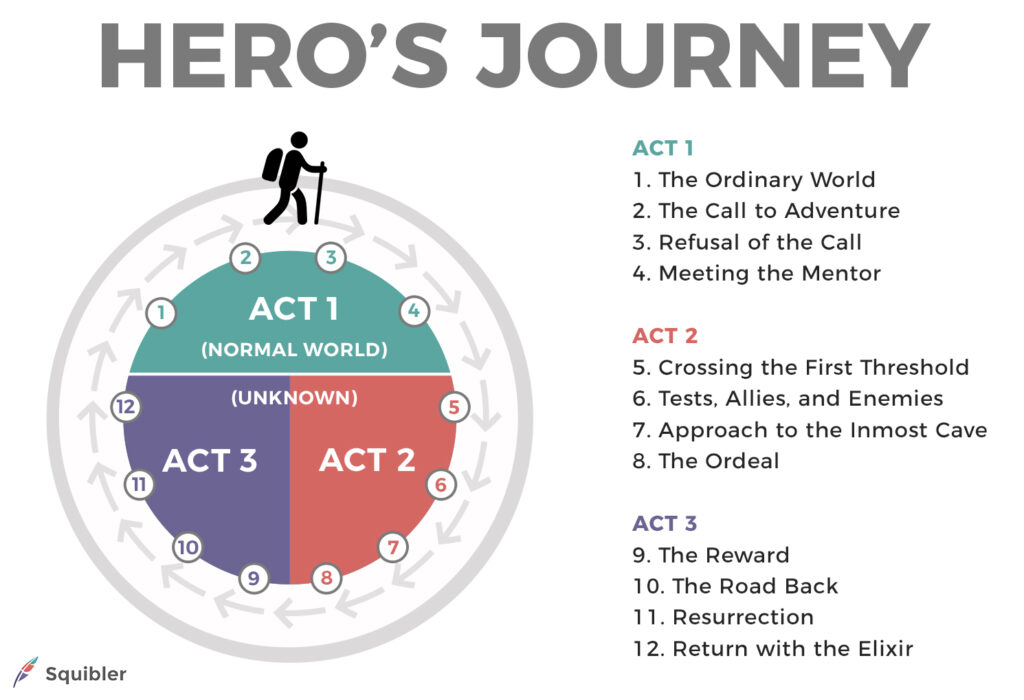
Here, you follow Campbell’s structure through stages like the ordinary world, call to adventure, mentor meeting, tests, challenges, and resolution. It’s a great fit for stories where the main character goes through a major journey or personal transformation.
Chapter-by-Chapter Summary
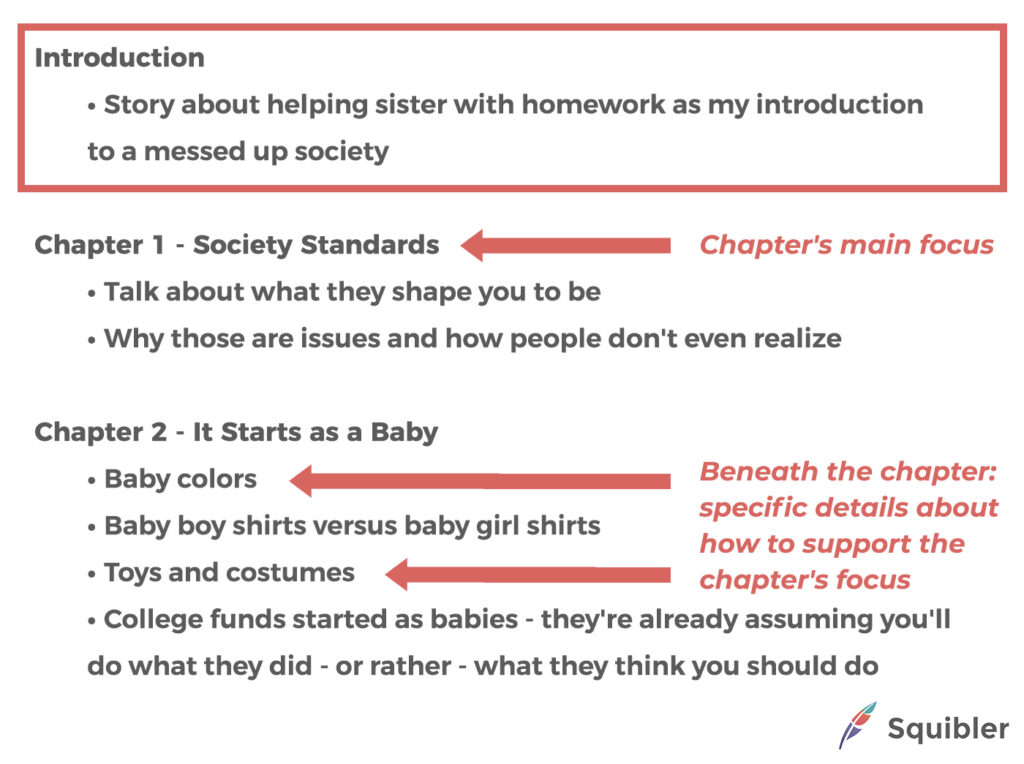
This applies if you’re writing nonfiction; create a detailed table of contents with key points under each chapter heading to establish your logical flow and main arguments.
Now it’s time to break your book into smaller, manageable chunks by setting clear content milestones. This helps you stay on track, avoid writer’s block, and keep the pacing just right. Set goals for each section, like what a chapter should cover, how long it should be, and when you want it finished. Use tools like storyboards, mind maps, or writing apps to track your progress and keep the momentum going.
Draft Your Book
Consistent writing habits produce very real results.
Tools like Squibler have a Smart Writer feature that helps overcome blocks with options likegenerate scene for creating character dialogues.
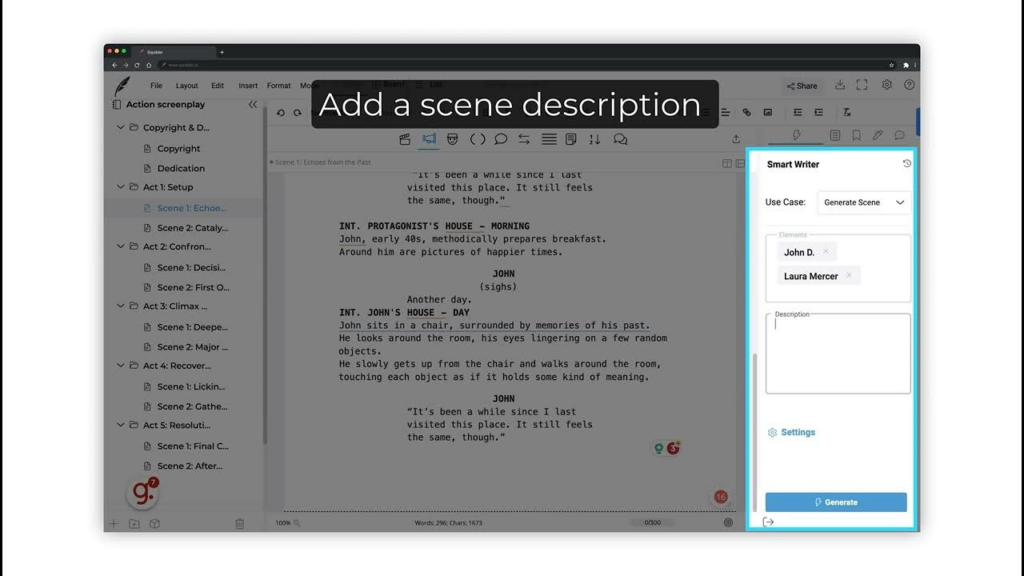
Self-Edit for Clarity and Flow
Before sending your manuscript to an editor, give it a break for a week so you can come back with fresh eyes.
Read it out loud to catch clunky phrasing or pacing issues you might miss silently. Use tools like Grammarly, Hemingway Editor, or ProWritingAid to clean up grammar, simplify sentences, and spot bigger style issues. Focus first on fixing plot holes, character inconsistencies, or confusing sections. Save the small stuff for later.
Step 3 – Get Professional Editing and Feedback
Even experienced authors need outside perspectives to polish their work. Make sure you have a solid community for feedback and trusted professionals to edit your draft.
Understand the Types of Editing
Different editing stages serve distinct purposes.
The developmental editing
stage examines big-picture elements like structure, plot, character development, and theme.
Copyediting
: Focuses on clarity, consistency, tone, and grammar at the sentence level.
Proofreading
: Catches final typos, formatting issues, and minor errors before publication.
Many successful authors invest in all three for their books to ensure professional quality.
Find the Right Editor
The right partnership makes all the difference.
You can look at marketplaces like Upwork, specialized Facebook groups like Editors for Indie Authors, or ask for referrals from author associations. Review your editor’s portfolio for experience in your genre.
Once you’re sure about the editor, you can create a detailed agreement covering scope, timeline, revision rounds, and payment terms.
Beta Readers and Early Feedback
Before you hit publish, it helps to get some honest feedback. Beta readers can give you a fresh perspective on your story—what’s working, what’s confusing, and what might need a little more polish.
You can find them through your email list, writing groups, Facebook communities, or sites like BetaBooks and StoryOrigin. It’s a great way to catch things you might’ve missed and make your book even better.
Look for patterns across multiple readers rather than changing direction based on one opinion. Stay true to your vision while addressing valid concerns.
Step 4 – Design a Book That Sells
Your book’s design is one of the first things readers notice, and it can make or break their decision to check it out. A professional, eye-catching cover helps your book stand out in a sea of others. It should clearly show what kind of book it is, who it’s for, and what kind of vibe it has.
Your Title and Subtitle Need To Have Impact
Your title is your first marketing tool. So make sure it’s something that readers remember.
Follow Genre Conventions
Nonfiction titles should clearly promise value, like The 4-Hour Workweek by Tim Ferriss, which offers a path to escape the 9–5 and live life on your own terms.
Fiction titles, on the other hand, should spark curiosity or emotion. A great example is Where the Crawdads Sing by Delia Owens, which evokes a strong sense of mystery and atmosphere.
Include Relevant Keywords
For nonfiction, use keywords that readers might search for. Your subtitle is a great place to add extra keywords and boost discoverability.
Test Multiple Options
Try a few title options and see what clicks. You can run polls in your newsletter or on social media, or test different titles using Amazon ads to find out which one gets the most attention.
Author Dave Chesson changed his book title from “Kindle Keywords” to “Amazon Keywords” after keyword research showed the latter had a significantly higher search volume.
Create a Professional Book Cover
Like it or not, your book cover makes a crucial first impression! So, you need to make sure it looks professional, fits your genre, grabs attention, and gives readers a clear idea of what to expect inside.
Understand genre expectations
– Study bestseller covers in your category for color schemes, typography, and imagery. Romance readers expect different visual cues than thriller fans.
Pass the thumbnail test
– Keep your cover simple, bold, and clear so it stays eye-catching even as a small Amazon thumbnail.
Invest in professional design
– While DIY tools like Canva can work for simple covers, most successful authors hire professionals to create memorable covers.
Provide clear direction
– When working with a designer, share a brief that includes your genre, target readers, mood, themes, and examples of covers you like. This helps them bring your vision to life.
Interior Formatting for Print and eBook
Professional formatting enhances the reading experience. For example, eBooks use reflowable text that adapts to different devices, while print books require fixed layouts with proper margins and bleed areas.
Post that, you pay attention to details. Include proper front matter (title page, copyright page), back matter (about the author, other books), chapter breaks, and consistent font choices.
Pro tip: Create a clickable table of contents for eBooks, as it improves navigation.
Step 5 – Choose From the Right Self-Publishing Platforms
Where you publish your book determines how many people you reach, how much money you make, and how you can market it. It’s a key decision that shapes your whole strategy.
Enrolling exclusively with Amazon grants access to Kindle Unlimited subscription readers and promotional tools like Countdown Deals. Authors earn from both sales and page reads.
Many self-publishing platforms offer different pros and cons. Keep this in mind when you want to compare various self-publishing platforms and their offerings for your first or your next book. Also, consider factors like your long-term publishing goals, global reach, support for multiple formats, and how hands-on you want to be with distribution and promotion.
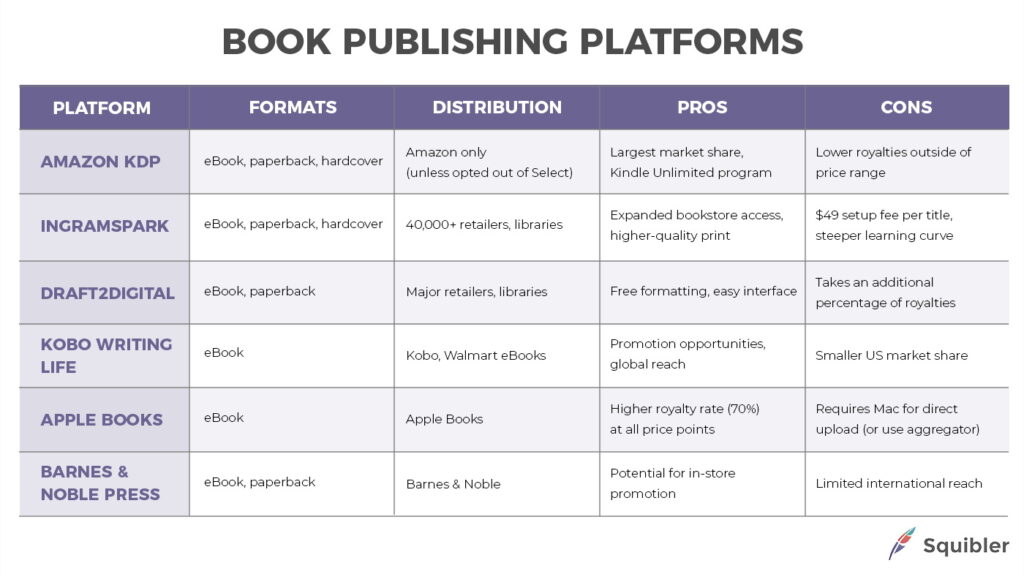
Follow these steps to get your book live:
Set up your account
: Create accounts on your chosen platforms. Amazon’s Kindle Direct Publishing requires tax information and banking details for royalty payments.
Prepare your metadata
: Write a clear, imaginative book description using keywords. Choose the most relevant categories (usually between 2 and 7, depending on the platform) to make sure your book shows up to the right audience.
Upload your files
: Submit your formatted interior file and cover. Most platforms accept EPUB for eBooks and PDF for print.
Set pricing and royalties
: Consider genre standards, page count, and promotional strategy when setting up pricing.
Review your listing
: Use preview tools to make sure your book looks good on all devices before publishing.
Set your publication date
: Decide whether to release your book immediately or set a date to allow for pre-orders.
Step 6 – Set Your Pricing and Royalties
Strategic pricing affects both visibility and revenue. Start by understanding royalty structures and remember that different platforms and price points yield varying returns.
Amazon eBook Royalties
According toAmazon, if you choose the 70% royalty option on Amazon, you’ll earn 70% of your book’s list price (excluding VAT) for sales in select countries. For sales outside those countries, your royalty drops to 35%.
Here’s the formula to calculate royalties:(List Price – Printing Cost) × Royalty Rate.
Example: On a $14.99 paperback with a $4.50 printing cost at 60% royalty:
($14.99 – $4.50) × 0.6 = $6.29 per copy
Other Platforms Royalty Variations
Apple Books gives a flat 70% royalty while Kobo offers 70% for books above the price of $2.99 and 45% otherwise.
Draft2Digital lets you keep 60% of the list price of your eBook. For print books, you will make about 45% of the list price of your print book minus the base printing cost.
How to Choose the Right Price Point
Pricing your eBook is an experiment, not a set-it-and-forget-it step.Amazon gives you a 70% royalty if your print book is priced between $2.99 and $9.99, and if you go outside that range, it drops to 35%.
Many authors start at $0.99 to build reviews, then gradually increase the price. According to Smashwords, $3–$3.99 tends to be the most profitable range, but every book is different. Test, adjust, and focus on profit, not just sales.
Finding the optimal price balances visibility and profit.
Having said that, do your research before you decide on the pricing.
After you know market standards, you should considerbook length and perceived value. Readers expect longer print books or those with unique research to justify higher prices.
Remember, pricing isn’t set in stone. You can experiment with different price points to see what works best for your book and audience.
Lastly, you can set print-on-demand pricing based on production costs. Kindle Direct Publishing has afree price calculator that you can use to set prices for your eBooks and print books on Amazon.
Advanced Pricing Strategies
Once your book is out there, playing around with your pricing can help you reach more readers and boost sales. If you’re just starting or looking to grow your audience, these strategies can make a difference:
Launch pricing
– Consider a lower introductory price ($0.99-$1.99) for 1-2 weeks to generate reviews and momentum, then increase the price.
Series pricing
– Set a lower price for the first book in a series to attract new readers, and charge full price for the rest.
Promotional pricing
– Plan temporary price drops coordinated with newsletter features like BookBub or FreeBooksy to boost visibility.
Bundle pricing
– Bundle your print books into a box set and price it 30–40% lower than buying each one separately. Readers get a better deal, and you sell all your books at once.
Step 7 – Launch and Market Your Book
Even the best book needs visibility to reach readers, and building a pre-launch audience can help you make a strong entrance. In short, start marketing before your book is even out. Here’s how you can do that:
Create a website for yourself
– Create a regular website for yourself and include a newsletter signup form, book information, release dates, and sample chapters. WordPress, with a theme like Astra or Divi, offers affordable, professional-looking options.
Create an email list
– Offer a reader magnet (free short story, useful checklist, or sample chapters) to attract subscribers. Services like MailerLite or ConvertKit help manage your list.
Engage in communities
– Participate in relevant Reddit threads, FaceBook groups, TikTok conversations, and Goodreads discussions to add value.
Organize a Launch Plan
Create momentum around your release. You could do the following to build on this:
Create a Timeline and Prepare Your Author Profiles
Work backward from your launch date. An example schedule could look like this:
Set up distribution (more than 8 weeks before)
Cover reveal (6 weeks before)
Pre-order announcement (4-8 weeks before)
Launch team activation (2 weeks before).
Next, set up your Amazon Author Central page with a photo, bio, and social links. Also, create profiles on BookBub and Goodreads to boost your presence.
Plan Content Marketing
Once you finish setting up everything, you can schedule blogs, social media content, newsletter releases, podcast interviews, or guest posts around your launch.
A pro tip here is to have a mix of evergreen content and topical content to add value to your followers.
How to Get Reviews That Matter
Social proof significantly impacts buying decisions. So, build a group of 30-50 readers who receive advance reader copies in exchange for honest reviews on launch day. Manage them through StoryOrigin, BookSprout, Discord, or a specialized email list.
Follow Platform Guidelines so you get the best reviews in the right way. Amazon prohibits incentivized reviews(except through their Vine program),but giving free advance copies is permitted. Always include a note asking for “honest reviews” rather than positive ones.
The idea is to then target book YouTubers, book TikTokkers, and bloggers in your genre with personalized requests. Provide an engaging pitch, a professional media kit, and easy access to review copies.
Promotional Tools and Tactics
Expand your reach with strategic promotion. There are so many ways you can promote your book. Some of these are listed below.
Book promotion sites
– Services like BookBub Featured Deals, FreeBooksy, or The Fussy Librarian provide exposure to their reader email lists.
Amazon advertising
– Start with sponsored product ads targeting similar authors and relevant keywords with a daily budget of $5-$10, increasing spending on well-performing ads.
Social media advertising
– Facebook and Instagram ads work well when targeted to interest groups matching your reader demographics. Start with $5/day tests, scaling effective ads.
Organic content marketing
– Write guest posts for blogs your target readers follow, appear on relevant podcasts, or create shareable content related to your book’s theme.
Step 8 – Manage Your Book Rights and Author Business
Beyond writing and publishing, it’s important to treat your work like a business. That means understanding your rights, protecting your content, and setting up systems that help you grow and earn long-term.
Buy Your Own ISBNs (or Use Free Ones)
An ISBN, or International Standard Book Number, is a 13-digit unique identifier for books and book-like products. They aid in efficient book identification and management within the publishing industry and libraries. Consider the following when choosing your ISBN:
Paid ISBN options
– Purchase from
),
, or your country’s agency. Costs range from $125 for one ISBN to $575 for 10 in the US.
Free alternatives
– Amazon, Draft2Digital, and other platforms offer free ISBNs, but they list that platform as the publisher of record.
Strategic considerations
– Your own ISBNs give you complete publishing control and professional appearance in bookstores and library systems. They’re essential if you plan to approach bookstores or libraries.
Register Copyright (Optional but Recommended)
Protect your intellectual property at all costs. For example, if you want to register your book in the USA, you can do so with theU.S. Copyright Office for $45-$65 per title. Similar processes exist in other countries, too. They are all a Google search away.
You should register within three months of publication for maximum legal protection. Your work is automatically copyrighted when you create it, but registering it gives you stronger legal protection, like the ability to claim damages and legal fees if someone copies it.
Track Sales and Royalties
Managing your business finances can get confusing over time, especially for first-time authors. It’s helpful for you to have the following tools to manage them better:
Monitoring tools
– Use KDP Reports for Amazon sales, individual dashboards for other platforms, or aggregators like
Book Report or ScribeCount to track all sales in one place.
Financial management
– Track business expenses such as editing, cover design, and marketing for tax purposes.
Business structure
– Consider forming a company once your annual book income reaches $5,000-$10,000 to separate personal and business finances.
So many authors treat their self-publishing as a business to inform release schedules and promotional timing. You can be one of them.
Step 9 – Expand Your Reach with Additional Formats
Give your book more ways to reach readers by offering it in multiple formats. Whether it’s an eBook, paperback, hardcover, or audiobook, each version helps you connect with different audiences and boost your overall sales.
Try Out Audiobooks as a Format to Diversify
Audiobooks are one of the fastest-growing segments in publishing, making them a smart choice for authors looking to reach more readers, especially those who prefer listening over reading.
If you’re one, you might want to consider the following:
Production options
– Use ACX (Audible’s production marketplace) to find narrators on a royalty share or for hire. Alternatives include Findaway Voices for wider distribution and Spotify’s newer audiobook platform.
Narrator selection
– Choose between narrating yourself or hiring professionals. Most fiction books benefit from professional narration.
Cost considerations
– Professional narration can cost anywhere between $10-$400 per finished hour. A 70,000-word book usually creates a 7.5-hour audiobook, resulting in a $75 to $3,000 total production cost.
Distribution strategy
exclusive (40% royalties) or non-exclusive (25% royalties) options. Findaway provides non-exclusive distribution to 40+ platforms at varying royalty rates.
You Can Sell Directly to Readers
Build a direct sales channel. Sell eBooks and digital products directly through services like Payhip, Gumroad, or BookFunnel’s delivery service, paired with a payment processor.
The Benefits
It captures full retail price instead of just royalties, builds direct customer relationships, and collects reader emails for future marketing.
Bundle Your Opportunities
Create exclusive bundles that combine eBooks with bonus content, audiobooks, or related digital products at premium prices.
Integrate with Direct Sales Channels
Connect your direct sales to your email marketing channels for seamless delivery and follow-up nurture cadences to flow.
Explore Foreign Markets and Rights Licensing
Now, think big! Expand globally with translations and rights deals. This will allow you to broaden your audience and reader base globally. Some of the options you have to go all out are:
Translation options
– Use services like Babelcube or freelancing platforms to find good translators who work for a royalty share.
Rights licensing
– Work with agents specializing in foreign rights to connect with international publishers.
International marketing
– Focus on country-specific Amazon stores, local promotional sites, and translated landing pages to reach non-English speaking markets.
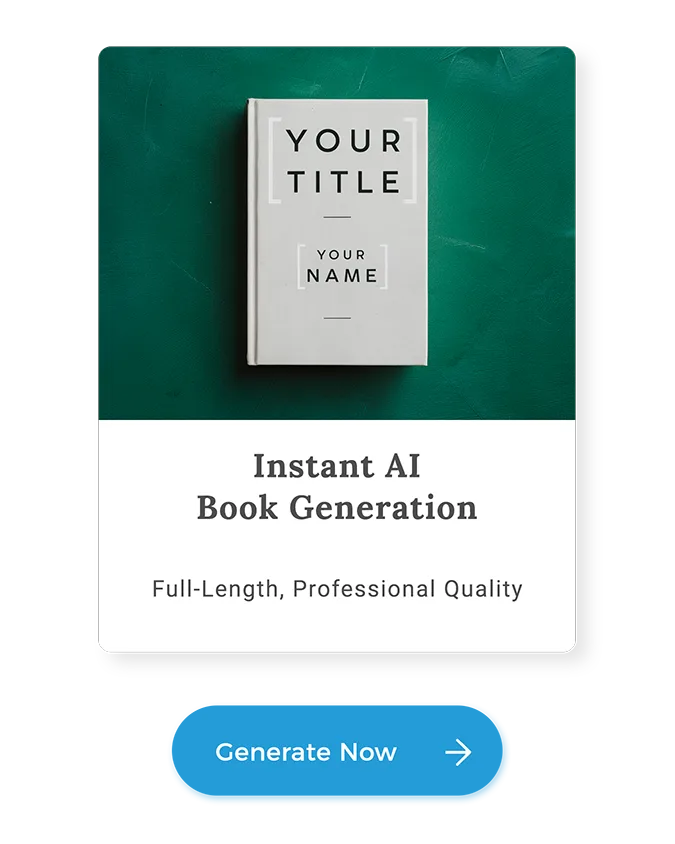
Some Common Mistakes to Avoid when Self-Publishing
There are many benefits of self-publishing, but even experienced authors can fall into the following traps. To know them is to know you can avoid them when publishing your book. Here are some common mistakes:
Rushing to Publish Without Proper Editing
It’s important to take your time during this stage, especially because typos and structural issues damage reader trust and lead to negative reviews. You don’t want these to haunt your book permanently.
DIY Cover Design Without Design Experience
If not worked properly, homemade covers may seem amateurish to potential readers, which reduces click-through rates when compared to professional designs. So, make sure your cover looks professional, clean, and has a layered perspective.
Ignoring Formatting Standards
Improper formatting, such as bad indentation, uneven spacing, or missing chapter breaks, makes your book hard to read. This can lead to negative reviews and even returns.
Launching Without a Marketing Plan
Hitting “publish” and hoping for the best usually doesn’t give great results. Print books need a solid marketing push both before and after launch to get noticed. That’s why you need a plan in place well before your book goes live.
Neglecting Metadata Optimization
Choosing the wrong keywords or categories on platforms like Amazon KDP can make it much harder for readers to find your book. Getting these right is key to showing up in search results and bestseller lists.
Setting Unrealistic Expectations
Building a readership doesn’t happen overnight. Even the most successful authors had to publish several print books before they started gaining traction. So, be patient and keep showing up.
Start Self-Publishing Today
Self-publishing platforms offer great opportunities for writers to share their work with the world while maintaining creative control and earning higher royalties.
Self-publishing means taking on many roles like writer, editor, designer, and marketer, but the rewards can be well worth the effort.
The idea of connecting directly with readers and building a sustainable author business makes it worth your while. After all, the self-publishing process is a marathon, not a sprint!
Each book builds on the foundation of the last, growing your skills, audience, and income over time.
Frequently Asked Questions
Here are some of the most common questions asked about book publishing.
How much does it cost to self-publish a book?
The cost varies widely depending on the quality and services chosen. A professionally self-published book requires approx. $1,500-$5,000 investment, covering editing, design, formatting, ISBN purchase, and initial marketing expenses.
But you can reduce costs by learning some skills or bartering services to lower the investment significantly.
Can I make money from self publishing?
Yes, many authors earn sustainable income through self publishing.
The median income of full-time self-published authors in 2022 was $12,800 from print books and $15,000 in total from all author-related activities.
Can self-published books become bestsellers?
Absolutely. Many self-published books have become bestsellers. Authors like Colleen Hoover and Andy Weir started self publishing before landing major success. With great content, smart marketing, and persistence, it’s possible.
How long does the process take from idea to live book?
For a quality self-published book, expect 6-12 months from concept to publication.
This timeline includes 3-6 months for writing (depending on length and research needs), 1-2 months for editing and revisions, 2-4 weeks for design and formatting, and 1-2 months for pre-launch marketing.
